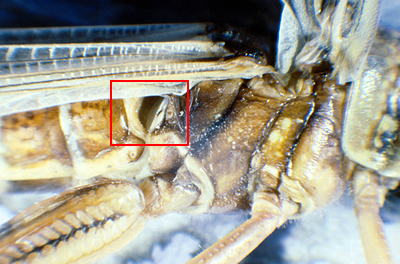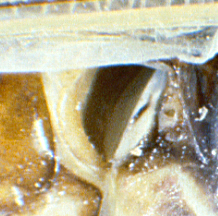

Grasshoppers are basically vegetarian. If you catch one and want to keep it, then feed it fresh grass or lettuce (not sprayed with insecticide!), and some wheat bran in a shallow dish. If the green vegetables are reasonably moist then you probably don't need to provide water, but a saucer of water will do no harm.
All facts and figures depend upon the species and environment, but typically the female grasshopper uses spade-like ovipositors (egg-depositors) on the end of her telescopic abdomen to dig a shallow hole in the soil, in which she lays a "pod" of about 50 eggs. After about 3 weeks (depending on the temperature) the eggs hatch and tiny wingless "hoppers" emerge. These eat voraciously, and go through 4 or 5 moults, getting bigger each time, over a period of about a month. The final moult reveals the adult form, which in most grasshopper species has wings. The adults become sexually mature after about 2 weeks, and then live for about a further 6 weeks, during which time they eat and breed (repeatedly, both).
This cycle can be suspended for weeks or months at almost any stage if conditions become unfavourable. Typically, eggs laid in the autumn might not hatch until the following spring,
Most grasshoppers lead relatively blameless lives, causing little harm to crops or gardens. However, some species of grasshoppers lead a "Jekyll and Hyde" existence, and can change into a very damaging form indeed, in which they congregate in huge swarms that can do severe damage to crops. These swarming grasshoppers are called locusts. There are more than 20,000 species of grasshoppers known to science, but only about a dozen of these form damaging swarms.
One swarm in 1988 covered an area of 75 x 15 miles, contained (about) 150 billion locusts and was estimated to be eating 300,000 tons fresh green food per day.
Locusts have two "phases" of existence. When the animals are not crowded together, they exist in the solitary form. In this form they act just like other grasshoppers - they have no tendancy to form swarms (in fact they will spread out as much as possible in order to avoid each other), and they do little damage. They can exist in the solitary form for many generations. However, if the population increases to the extent that the animals become crowded together, then they switch to the gregarious form. This form actually looks different to the solitary form, to the point that one would think it was a completely different species. However, it is not the change in appearance which is the problem, it is the change in behavior. Locusts in the gregarious phase really like each others company; they join together in huge enormous swarms (we're talking billions of locusts, covering hundreds of square miles in the worst cases) and eat just about every green thing they encounter.
The change in behaviour can occur very rapidly (within a few hours), and it is touch that is the main trigger for the switch (the sight and smell together of the other locusts in the crowd helps, but is not as effective as touch). But not just any touch - the touch has to be specifically on the femur ("thigh") of the back legs. This was shown by a scientist painstakingly tickling individual solitary locusts with a paintbrush for four hours! Only tickling the femur induced the switch from solitary to gregarious behaviour; tickling other parts of the body had no effect. Appropriate touching causes a big increase in the level of a neurohormone called serotonin in the locust nervous system, and this seems to be the necessary trigger for the actual behavioural change.
A more attractive feature of some grasshoppers is their ability to sing. It's the males that sing, and they do it to attract female mates, or to warn off other males. There are two different mechanisms for singing. In one (used by short-horned grasshoppers), there is a comb-like structure with a row of teeth on the inside of the hind leg, which gets rubbed against a ridge on the wing (a bit like running a stick along a fence very quickly). This produces a "chirp" sound. In the other mechanism (used by crickets and long-horned grasshoppers) there is again a comb-and-ridge mechanism, but the structures are on the left and right fore-wings, which rub over each other.
Short horned grasshoppers have ears in the sides of the abdomen.


Long-horned grasshoppers and crickets have ears in the knee-joints of their front legs.
Incidentally, cicadas sing very well but they are not grasshoppers (they belong to the group Hemiptera, which are the true bugs).